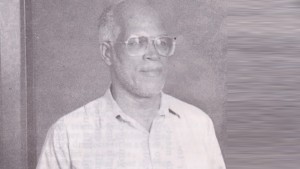
Clarence Fitzroy Bryant
27th February 1937 – 12th March
1997
Clarence Fitzroy Bryant was born on 27th February 1937 in Antigua. His early education was at Miss Ruth Elmes Private School and the Hilda Davis Primary School both in Antigua. At the age of 9 he moved to St. Kitts with is mother, Mr. Anne Liburd, and attended the St. Johnson’s Village School at the time headed by George Elroy Lewis.
At age 11 he won the Lord Blackburne Scholarship to the St. Kitts-Nevis Grammar School. At age 16 he graduated with his Senior Cambridge Higher Education Certificate. He taught for a number of years at the St. Kitts-Nevis Grammar School. Although he taught French and Latin he was considered by all to be a master at the teaching of English. He taught English privately and at classes which he organised on behalf of the St. Kitts-Nevis Trades and Labour Union at no personal gain.
He successfully completed the Bachelor of Arts externally with University of London. He gained the LLB with that University and later graduated from Lincoln’s Inn as a lawyer and solicitor. Politically he grew up through the ranks of the St. Kitts-Nevis Labour Party and became President of Young Labour and Chairman of the Party.
He was first elected to parliament in 1966 and was given the portfolios of Education, Health and Social Affairs. At one time he also served as Attorney-General. He was a parliamentarian from 1966 until 1980.
As Minister of Education, he was responsible for introducing the comprehensive system in schools in St. Kitts and Nevis. This was a bold initiative that decentralized education in this country and broke down social barriers. It was a revolution not only in education but in the social, cultural, political and economic life of St. Kitts and Nevis.
The evening Institute was of his creation and it was of his constant nagging at regional meetings of Education ministers that was mainly responsible for students of non-campus territories being able to write 1st year (U.V.I) university courses at home. It is to his eternal credit that his vision for education included the formation of a college of further education. Now that his plan has materialized and the physical structure is completed it is only fitting that it be named the Clarence Fitzroy Bryant College of Further Education.
